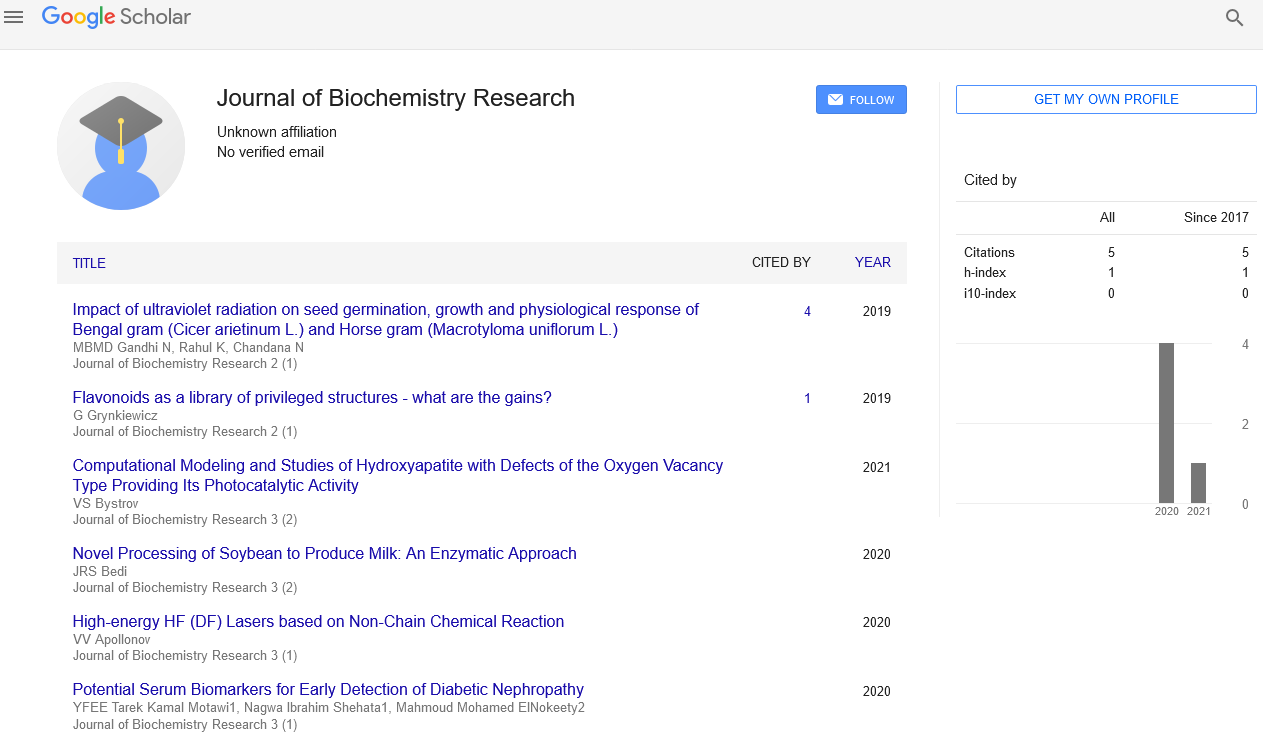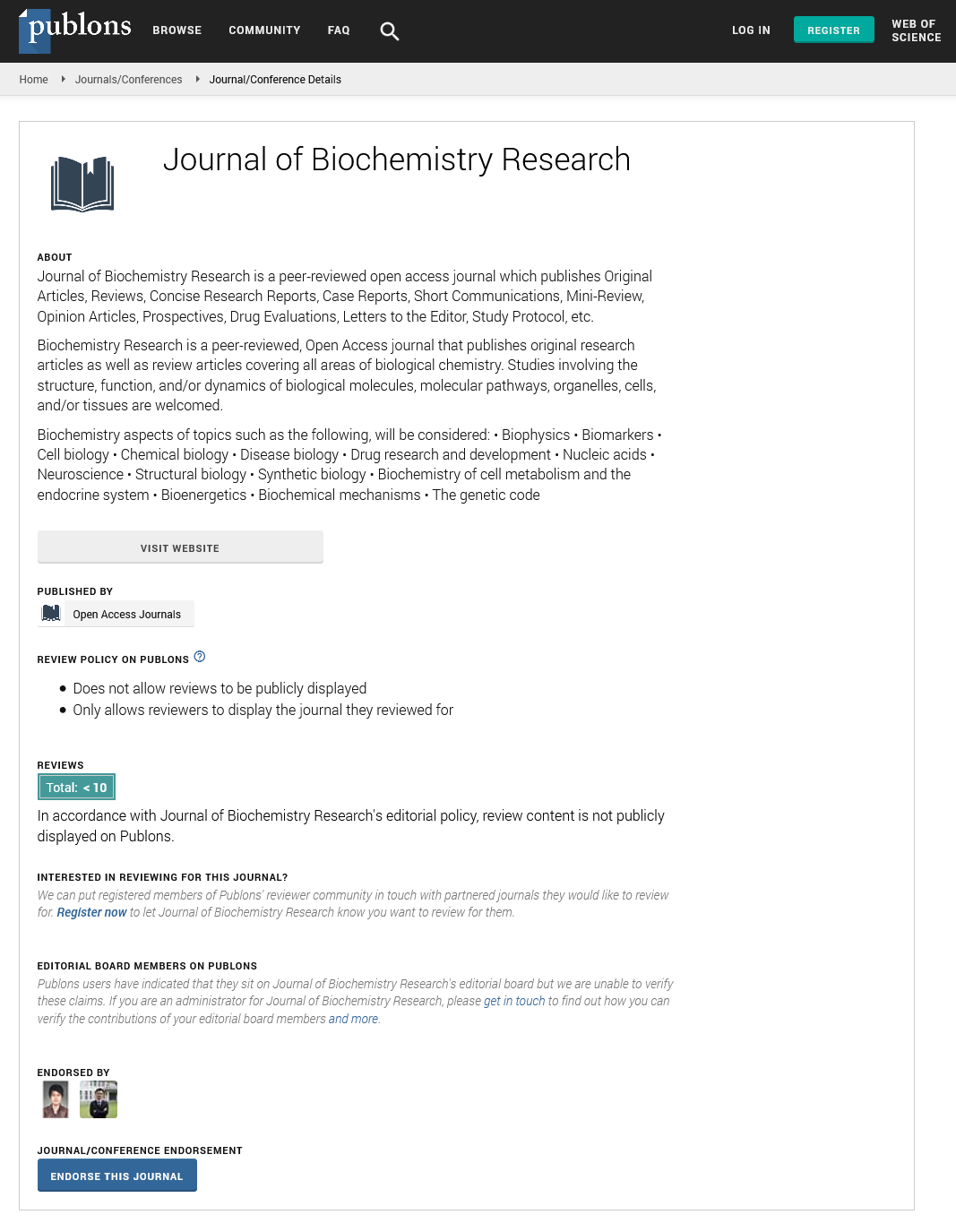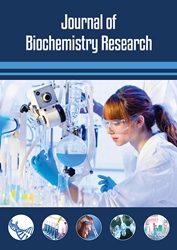Editorial - Journal of Biochemistry Research (2023) Volume 6, Issue 4
Evolutionary Insights into Enzymes: Unraveling the Molecular History of Biological Catalysts
Shanti Niketan*
Department of Biotechnology, Chandigarh University, India
Department of Biotechnology, Chandigarh University, India
E-mail: ShantiNiketan54@gmail.com
Received: 1-August-2023, Manuscript No.oabr-23-109712; Editor assigned: 4- August-2023, Pre-QC No.oabr-23-109712 (PQ); Reviewed: 14-August-2023, QC No.oabr-23-109712; Revised: 22-August-2023, Manuscript No.oabr-23-109712 (R); Published: 31-August-2023, DOI: 10.37532/oabr.2023.6 (4). 103-106
Abstract
The study of enzyme evolution offers profound insights into the origins and diversification of these fundamental biological catalysts. Enzymes have played a central role in driving the myriad of chemical reactions that sustain life, and understanding their evolutionary history sheds light on the molecular mechanisms that have shaped their catalytic functions across diverse organisms. This article in the Journal of Biochemistry Research delves into the evolutionary journey of enzymes, highlighting the interplay of genetic mutations, gene duplications, horizontal gene transfers, and natural selection in sculpting their structures and functions over time. By employing molecular phylogenetics, comparative genomics, and structural biology, we reveal the evolutionary relationships among enzyme families, uncovering shared ancestral origins and the adaptive pathways that have led to their contemporary roles. Functional diversification and neofunctionalization emerge as key drivers behind the expansion of enzyme families, enabling the emergence of novel catalytic activities that confer selective advantages to host organisms. Furthermore, the occurrence of convergent evolution in enzymes illustrates the remarkable adaptive potential of these catalysts, as unrelated organisms independently evolve similar functions in response to comparable selective pressures. Additionally, horizontal gene transfer events have facilitated the exchange of enzymatic functions across taxa, resulting in catalytic promiscuity and intricate networks of enzymatic interactions. This article discusses the broader implications of understanding the molecular history of enzymes for various scientific disciplines, including biotechnology and medicine. By deciphering the evolutionary trajectories of enzymes, researchers can harness and engineer these ancient catalysts for diverse applications, ranging from industrial processes to medical therapeutics. In conclusion, this article provides a comprehensive overview of the evolutionary insights into enzymes, illuminating the dynamic interplay between molecular evolution and biological function. Through this exploration, we gain a deeper appreciation for the extraordinary adaptability and indispensability of enzymes in shaping the tapestry of life on Earth. The findings presented herein open up new avenues for future research and technological advancements, with the potential to revolutionize various industries and improve human well-being.
Keywords
Enzymes • Evolutionary insights • Molecular history • Biological catalysts • Catalytic function
Introduction
Enzymes are the molecular workhorses that underpin the diverse biochemical processes essential for life. These remarkable biological catalysts accelerate chemical reactions with unparalleled efficiency, enabling organisms to perform an astonishing array of tasks, from metabolizing nutrients to synthesizing essential molecules [1]. Throughout the course of evolution, enzymes have played a pivotal role in shaping the intricacies of life’s molecular machinery, adapting to changing environments, and driving the emergence of complex organisms [2]. The study of enzyme evolution provides a window into the deep past of life on Earth, offering evolutionary insights that illuminate the molecular history of these ancient catalysts. By deciphering the dynamic interplay of genetic mutations, gene duplications, horizontal gene transfer, and natural selection, scientists can trace the evolutionary trajectories that have sculpted enzymes into the diverse and functionally versatile entities we observe today. In this pursuit of understanding, molecular phylogenetics, comparative genomics, and structural biology serve as powerful tools that unravel the ancestral relationships between enzyme families and shed light on their shared evolutionary origins [3]. The identification of common ancestral roots and the delineation of divergent paths guide us through the vast tapestry of enzyme evolution, revealing how these catalysts have adapted and specialized to meet the unique demands of their host organisms. The driving forces behind enzyme evolution extend beyond mere genetic changes. Functional diversification and neofunctionalization have been instrumental in expanding the scope of enzyme families, endowing them with new and distinct catalytic functions. Convergent evolution emerges as a testament to the extraordinary adaptability of enzymes, showcasing how unrelated organisms have independently converged on similar catalytic activities in response to similar selective pressures [4]. Moreover, the phenomenon of horizontal gene transfer has allowed enzymatic functions to traverse the boundaries of species, disseminating catalytic promiscuity and giving rise to intricate networks of enzymatic interactions. This transfer of genetic material has not only facilitated the evolution of new metabolic pathways but has also shaped the adaptive potential of organisms, allowing them to thrive in diverse ecological niches. The implications of unraveling the molecular history of enzymes extend far beyond theoretical knowledge. Insights gleaned from enzyme evolution have found practical applications in biotechnology, where these catalysts are harnessed and engineered for industrial processes and medical therapeutics. By understanding the adaptive strategies that have driven enzyme evolution, researchers can design tailor-made catalysts to address societal challenges and improve human well-being. In this pursuit of evolutionary insights into enzymes, we embark on a journey that unveils the ancient origins, dynamic adaptations, and far-reaching consequences of these biological catalysts. By delving into the molecular history of enzymes, we gain a deeper appreciation for the intricate processes that have shaped life’s diversity and complexity [5]. The knowledge acquired from this exploration not only enriches our understanding of the past but also inspires new possibilities for harnessing the catalytic power of enzymes to shape a more sustainable and healthier future [6].
Discussion
Ancient Origins and Early Enzymes: Investigating the molecular history of enzymes provides a glimpse into the early stages of life’s emergence [7]. Understanding the catalytic functions of primordial enzymes can shed light on the chemical processes that were instrumental in the transition from simple chemical reactions to the complex biochemistry seen in modern organisms. Co-evolution of Enzymes and Organisms: Enzymes have co-evolved with organisms over millions of years, responding to changes in environmental conditions and adapting to new ecological niches. The reciprocal relationship between enzymes and their host organisms has driven the diversification and specialization of enzymatic functions. Molecular Phylogenetics and Enzyme Families: The application of molecular phylogenetic methods has enabled the reconstruction of enzyme evolutionary trees, revealing the evolutionary relationships and shared ancestry among enzyme families [8]. Comparative genomics has further provided insights into the distribution and conservation of enzymatic functions across diverse species. Mechanisms of Enzyme Diversification: The discussion can explore the mechanisms behind the diversification of enzyme families, including gene duplications and subsequent functional divergence, as well as horizontal gene transfer events that have contributed to the transfer of enzymatic functions between different organisms. Functional Innovation and Neofunctionalization: The concept of neofunctionalization, where duplicated genes acquire new functions, is particularly relevant in the context of enzymes [9]. Understanding how novel enzymatic activities have arisen through neofunctionalization offers valuable insights into the adaptive potential of enzymes. Convergent Evolution in Enzymes: The occurrence of convergent evolution in enzymes, where unrelated organisms independently evolve similar catalytic functions, highlights the powerful role of selective pressures in shaping enzymatic evolution [10]. This discussion can delve into specific examples of convergent evolution in enzymes and the implications for our understanding of adaptive evolution. Catalytic Promiscuity and Enzyme Evolution: Catalytic promiscuity, where enzymes possess multiple functions, can provide a starting point for the evolution of new enzymatic activities. The discussion can explore how promiscuity has influenced enzyme evolution and how this phenomenon has been harnessed for biotechnological applications. Biotechnological and Medical Applications: Evolutionary insights into enzymes have practical implications for biotechnology and medicine. This discussion can focus on how the knowledge of enzyme evolution has facilitated the design of novel biocatalysts, enzyme engineering for industrial processes, and the development of therapeutic interventions. Limitations and Future Directions: The discussion can address the current limitations in the study of enzyme evolution, such as the challenges in reconstructing ancient enzymatic activities and understanding the evolutionary events that occurred in deep time. Participants can propose future research directions and technological advancements to overcome these challenges. Ethical and Environmental Considerations: As enzyme applications continue to expand, the discussion can address ethical considerations surrounding the use of enzymes in biotechnology and their potential environmental impact. Strategies for sustainable and responsible enzyme engineering can be explored [11].
Conclusion
The exploration of enzyme evolution has provided invaluable insights into the coevolutionary processes between enzymes and organisms, showcasing how these catalysts have continuously adapted and diversified alongside the changing environments and ecological niches. The mechanisms of gene duplications, functional diversification, and neofunctionalization have been instrumental in the expansion and specialization of enzyme families, endowing them with the versatility to fulfill an impressive array of biological functions. Convergent evolution in enzymes demonstrates the remarkable adaptability of these catalysts, where unrelated organisms have independently evolved similar catalytic activities in response to similar selective pressures. This phenomenon underscores the intrinsic link between enzyme evolution and the demands of survival in diverse environments. The occurrence of horizontal gene transfer has facilitated the exchange of enzymatic functions across taxa, forging intricate networks of enzymatic interactions and promoting catalytic promiscuity. This transfer of genetic material has enriched the metabolic capabilities of organisms and has allowed for the exploration of novel biochemical pathways. Moreover, the practical implications of evolutionary insights into enzymes extend beyond theoretical knowledge. The knowledge gained from unraveling the molecular history of enzymes has found application in biotechnology and medicine, where these ancient catalysts are harnessed, engineered, and manipulated for diverse purposes. Enzyme engineering and the design of tailor-made biocatalysts have revolutionized industries and enabled novel therapeutic interventions. As we conclude this exploration into evolutionary insights into enzymes, we stand in awe of the remarkable adaptability and indispensability of these biological catalysts in shaping the tapestry of life on Earth. The knowledge acquired from this journey not only enriches our understanding of the past but also inspires new possibilities for harnessing the catalytic power of enzymes to address societal challenges and promote a sustainable future. Moving forward, continued research and interdisciplinary collaborations will be pivotal in overcoming the current limitations in the study of enzyme evolution, opening new frontiers in understanding ancient enzymatic activities and elucidating the evolutionary events that have shaped enzymatic diversity. In this pursuit, we are reminded of the profound interconnectedness between enzymes, life’s diversity, and the advancement of science and technology. As we continue to unravel the mysteries of enzyme evolution, we unlock the potential for innovative solutions to improve human well-being and foster a deeper appreciation for the intricate processes that have shaped the evolution of life’s most fundamental building blocks.
References
- Ogurtsova K, Fernandes JD, Huang Y et al. IDF Diabetes Atlas Global estimates for the prevalence of diabetes. Diabetes Res Clin Pract. 128, 40-50 (2017).
- Zhou Z, Mahdi A, Tratsiakovich Y et al. Erythrocytes From Patients With Type 2 Diabetes Induce Endothelial Dysfunction Via Arginase I. J Am Coll Cardiol. 72, 769-780 (2018).
- Sprague RS, Stephenson AH, EA Bowles et al. Reduced expression of Gi in erythrocytes of humans with type 2 diabetes is associated with impairment of both cAMP generation and ATP release. Diabetes. 55, 3588-3593.
- Blaslov K, Kruljac I, Mirošević G et al. The prognostic value of red blood cell characteristics on diabetic retinopathy development and progression in type 2 diabetes mellitus. Clin Hemorheol Microcirc. 71, 475-481 (2019).
- Venerando B, Fiorilli A, Croci G et al. Acidic and neutral sialidase in the erythrocyte membrane of type 2 diabetic patients. Blood. 99,1064-1070 (2002).
- Kadiyala R, Peter R, Okosieme OE et al. Thyroid dysfunction in patients with diabetes: clinical implications and screening strategies. Int J Clin Pract. 64, 1130-1139 (2010).
- Clark A, Jones LC, de Koning E et al. Decreased insulin secretion in type 2 diabetes: a problem of cellular mass or function. Diabetes. 50, 169-171 (2001).
- DeFronzo RA. Pathogenesis of type 2 diabetes: metabolic and molecular implications for identifying diabetes genes. Diabetes Reviews. 5, 177-269 (1997).
- Peppa M, Betsi G, Dimitriadis G et al. Lipid abnormalities and cardio metabolic risk in patients with overt and subclinical thyroid disease. J Lipids. 9,575-580 (2011).
- Cettour-Rose P, Theander-Carrillo C, Asensio C et al. Hypothyroidism in rats decreases peripheral glucose utilisation, a defect partially corrected by central leptin infusion. Diabetologia. 48,624-633 (2005).
- Dessein PH, Joffe BI, Stanwix AE et al. Subclinical hypothyroidism is associated with insulin resistance in rheumatoid arthritis. Thyroid. 14, 443-446 (2004).
Google Scholar, Crossref, Indexed at
Google Scholar, Crossref, Indexed at
Google Scholar, Crossref, Indexed at
Google Scholar, Crossref, Indexed at
Google Scholar, Crossref, Indexed at
Google Scholar, Crossref, Indexed at
Google Scholar, Crossref, Indexed at
Google Scholar, Crossref, Indexed at
Google Scholar, Crossref, Indexed at
Google Scholar, Crossref, Indexed at


